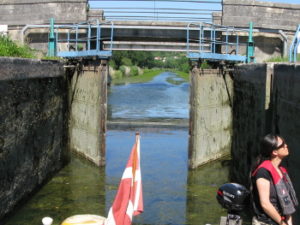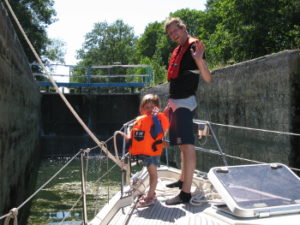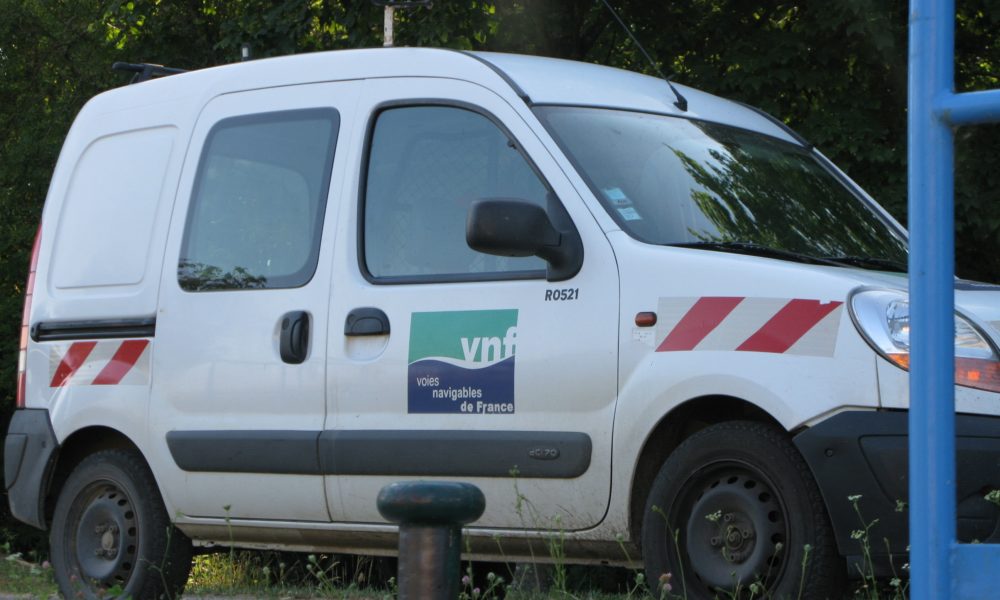
Help us out, we want out of the locks!
47° 27′ 41.8392” N 5° 22′ 19.6932” E
July 15, 2015
We are starting to get tired of the locks. We cannot bear any more of them. We have done more than a hundred locks since we started the holiday one and a half weeks ago. Now enough is enough.
The only sure cure for this is to sail out of the channel, and we still have 28 locks in front of us before we are done with Canal entre Champagne et Bourgogne and can sail into the river Saone. So we carry on with the locks again today.
The locks are close to one another at this side of the mountain. In turn, the weather has been a challenge. More than 30 degree celsius already at the end of the morning, we are confident. We therefor start early. Before eight o’clock. It gives us some cool hours, where everything works. But then we come to sail behind a peniche. And we are in a series of locks under remote control.
We call again and again to VNF. “Parles vour anglais?” We ask hopefully. “Pas du tout” is the response almost every time. And then we have the trouble. Per embarks on his through the winter updated French: “Ici batoux plaisance Ronja. Avalant (declining). Nous sommes a ecluse numero 32. The shit does not work. The lock is red, and not a damn thing is happening, when we use our remote control. ”
Amazing what you learn at evening-classes at FOF in Odense (running french-lessons) even without excessive diligence with homework.
VNF come and fix the error within 20 minutes. Only a very few times we have to make an additional call.
A place to moor for the night we find a kilometre after lock 35, Beaumont. We put Ronja under a grain silo. Only ship at the spot. No other boats have ventured to sail as far forward in the lock system this day.
Let’s get out of the locks. Tomorrow we have nine locks back, then there will be free passage down the Saone River, where we expect the city Auxonne to be the first stop for more than just one night. From there the rest of the tour will be 14 days with only 16 locks between us and the Mediterranean. Great.
Log book: Today’s distance: 33 km. Sailed time 7:45 to 18:00 = 10 ¼ hour. Locks: 20 !!! Weather: Sun all day. Possibly 35 degrees. We have no thermometer. But clearly one of the hottest days at all. We rig a large umbrella to create shade for the helmsman. Comfortable on the straights. A hassle during the lock operations.
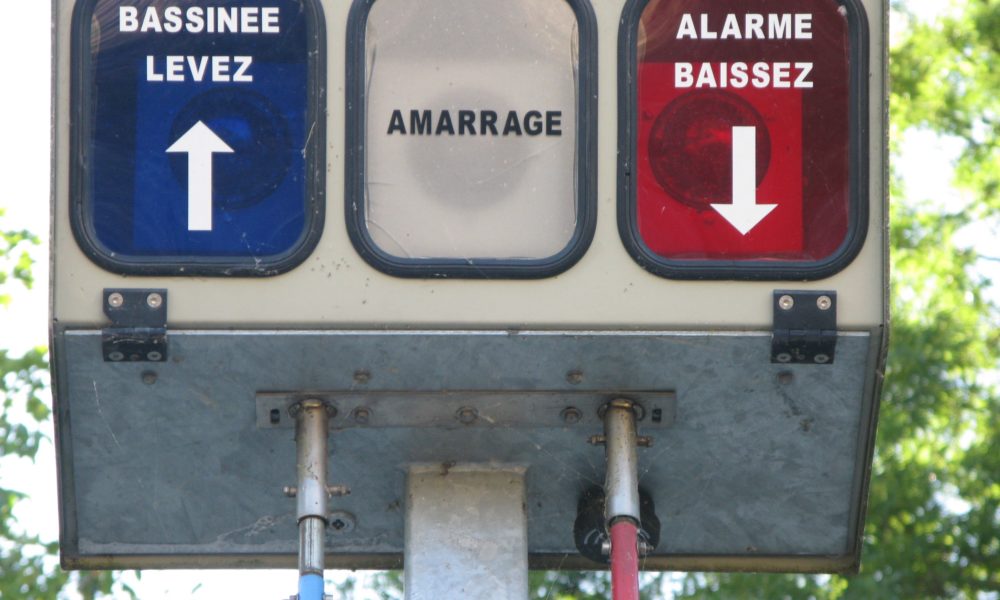
Hey! 24 locks in one day…
47° 41′ 2.2524” N 5° 20′ 41.3196” E
July 14, 2015
Effective day. And pretty exhausting. We have agreed with our neighbours from Bruges in Belgium, that we will break up with them as the first of four boats, and that we follow them through the locks. Their boat, Eva, is a broad-obsessed lady, totally strapped into a corset by huge fenders all around. They offer to go first into the locks. We say yes.
The day is laborious. Lock in and lock out. Some locks on this stretch are operated by young students ,who whiz off on their mopeds to make the locks ready for us. Others – the majority – are automated and controlled with the remote control, we have been given. Today’s highlight – literally – is a voyage through a nearly five-kilometre tunnel drilled through the mountain top. Dark, damp, clammy. Water drips onto our heads. The lighting is low, just enough that we can see to keep us in the channel. We keep a flashlight in reserve.
Our start in this tunnel, Balesmes sur-Marne, was governed in good bureaucratic French manner. A series of red and green lights in the tunnel ceiling are holding us back or invite us forward, depending on whether we are sailing too fast or too slowly. Circumstantially and annoyingly engineer-like. One senses that someone sits in a central office and plays with us.
The lock is a turning point. Since the beginning of Canal entre Champagne et Bourgogne, we have only been sailing upwards. 71 locks in total. 340 meters, we have been lifted since the channel start. From now on it is downhill. Right down to the Mediterranean, we think.
We use the first locks after the tunnel to get used to going down. It is said that this is much easier. More gentle to the ship and crew. For us, it is necessary however to catch the technique. In the first locks, we use the same technique, as when we locks up. Two hawsers. One for each, close to each other. It gives a sense of control when it goes up.
But going down there is not as much pressure from floodwaters in the lock chamber. The water disappears quietly under the boat. It is much calmer, and we become comfortable with simply having a single rope to the land, while we are experimenting with making as few moves as possible and let the boat take care of itself. A single puff with a boat hook or a single jerk in the hawser is enough. Yes, obviously it is easier to lock down than up. If it were not for the sun and heat, it would be pure relaxation.
We say goodbye to the Belgians after having sailed with them through 20 locks. Although we are taking additional four locks to Dommarien, which according to the map is a berth with 1.80 meters depth for two boats. It is not.
We hit the ground long before, we reach the quayside.
Instead we sail to the right side of the canal, where a converted peniche populated with young French people is located at the brink. We ask if we can moor side by side with them. No. They ask us to find another place. Rather unheard of. Sailors always give each other space. But they are probably landlubbers. Not sailors. Kirsten, frustrated, calls all sorts of curses upon the young landlubbers.
We must try again on the berth assigned in the chart. Nope. It is impossible. We cannot reach the shore. There continues to be one to one and a half meters between Ronja and the brink. We choose to make the boat stuck on this distance of the brink with the assistance of a helpful Frenchman. Well, anyway it does not seem temptating at all to go ashore, so we do not.
The helpful Frenchman seems to be new to sailing life. He has a small motorboat, which he has connected to the shore with three ropes and an anchor, which he has fixed on top of a little metal-bridge. We have never seen this before.
We celebrate with champagne today, the impressive distance and the fact that we have passed the peak and that the next few weeks of sailing goes down towards Saone, Rhone and the Mediterranean. A clear turning point.
Log book: Today’s distance: 35 km. Sailed time 8:45 to 19:15 = 10 ½ hour. Locks: 24 !!!! Weather: Sun all day. Light breeze made sure to dampen the unit. In these waters, the wind has only one meaning: To cool. To the navigation it has virtually no impact.
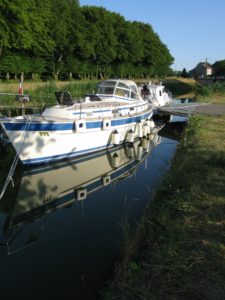
Sometimes you have to improvise finding mooring for Ronja
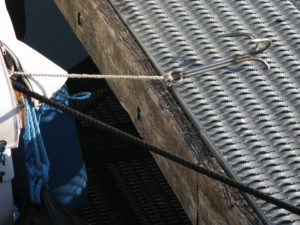
Not alle french sailors are trained in the craft of mooring. Her is a peculiar use of an anchor
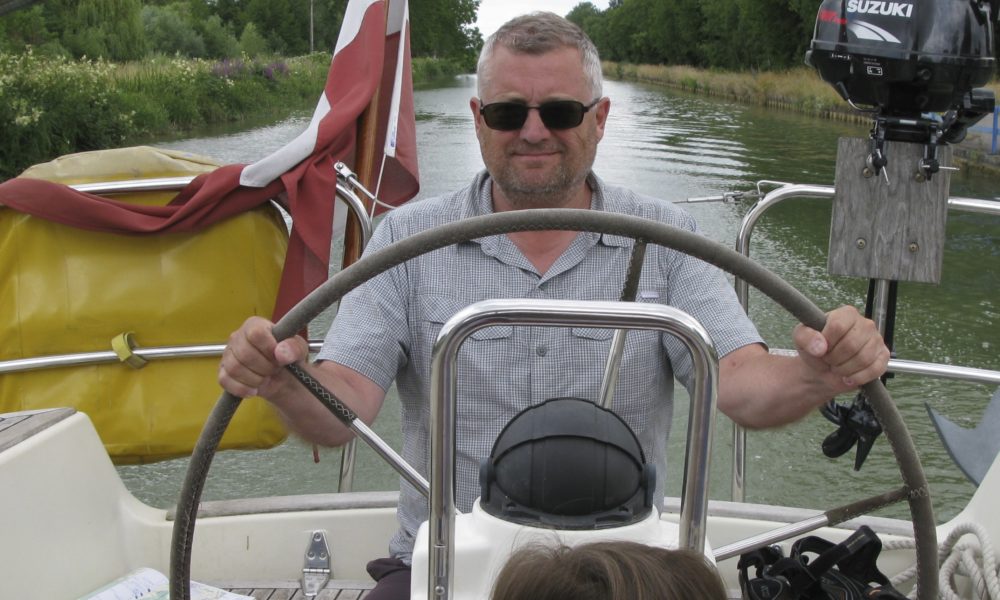
The lock system and almighty VNF sets the speed. Not you…
48° 18′ 1.7748” N 5° 8′ 48.9516” E
July 13, 2015
We say goodbye to Lasse, Tianling and Nellie. They want to go to Alsace, Germany and Denmark to find the wildest playground for Nellie. Instead of making departing into something sad, Lasse told Nellie that they now will start a hunt for a wild playground, and this project she is very pleased about. In today’s first lock they stand and wait and surprise us with an extra goodbye.
It requires patience to sail the French channels. The channel is in control. The lock system and the almighty VNF decide. Not you. Others set the pace.
You may be very much accustomed to the ways things are done back home on the job. You make things happen. Putting things off. Monitor progress. Intervene and speed up if a project loses momentum. On the canal is different.
The locks are based on a centuries-old system, which in recent years has been partially automated, but which are nevertheless based on the same routines and procedures. First notify your lock – via VHF radio, via a mechanical turn on a hanging rod or via a remote control – that you want to get through the gate. Then the lock reports back, that it has received your message, and it will start working on it. After some time – it can feel like a very long time – closes the farthest gate, and the emptying or filling of water begins. It takes time.
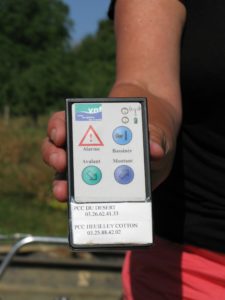
Remote control for operating the modernised locks. All is in french. But anyway the system is simple
From your position you can see the water gushing out, or – if you are on the decline – pouring into the lock chamber. When the water in the lock chamber has reached the same height as your part of the channel, which takes quite a while, a beep will sound and a flashing light shows, that now starts next stage in the process. The lock opens the lock chamber. It goes slowly. Very slowly. With high probability is this slowness carefully thought of some engineering minds, who wanted to avoid accidental rapid movements. Slowly, slowly, the front gate goes up. You can go in and find your place in the chamber.
Here begins the next phase. You give the lock a message via a mechanical lift on a blue rod or with the borrowed remote. You want to have the lock emptied or filled with water. It thinks a little about this. Often you may provide an additional signal. Again, the system is put together, so it makes quiet movements, time for reflection, time to get out of the way, no panic, in french: “lentement, lentement…”
There are those, who will argue, that it is healthy for the average busy person. Well there are even those who would argue, that this enforced tardiness is the very idea of a sailing holiday. Here you will be subjected to nature and other forces greater than yourself. Here you must adapt your thinking and your pace to others. Down to speed. Accept that others set the pace.
We are not angels. But perhaps it is still part of what we call the holiday, to be forced into a very slow pace.
Log book: Today’s distance: 29 km. Sailed time 9:30 to 16:00 = 6 ½ hours. Locks: 15 pcs. Weather: Perhaps the best sailing weather we had. Slightly overcast skies. Warm without being oppressive.
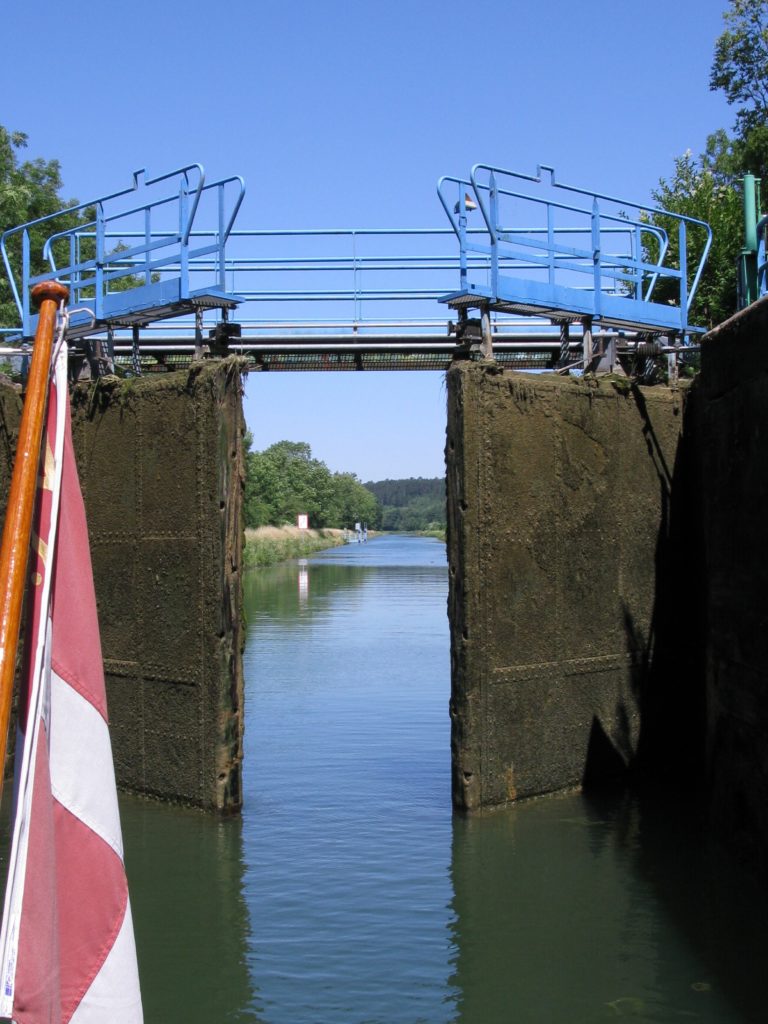
Locks forces you to go down in speed. Everything takes place in slowmotion. Probably good for something. Stress, maybe?
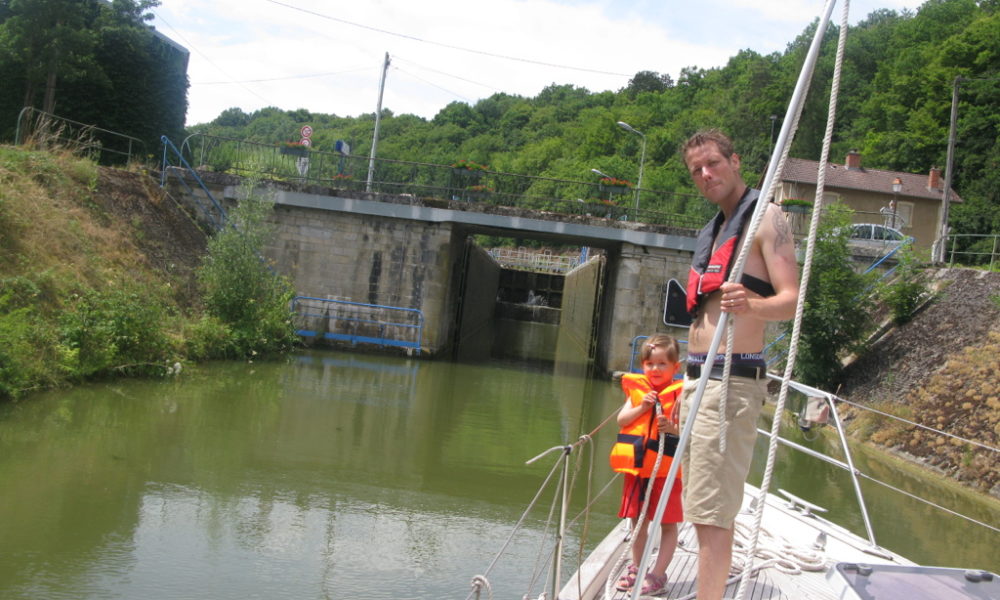
Worst distance till now: Ronja hit concrete-bottom
48° 26′ 36.5136” N 5° 8′ 15.6768” E
July 12, 2015
Today Kirsten is the one, who runs the family car. She takes it to Chaumont and will wait for Ronja to arrive mid-afternoon. It is the last day with a this car, it is returning to Denmark, and Kirsten fills the car with new 48 litres of spring water and a lot of other necessities. Later after bunkering we also go for 40 litres of diesel from a gas station three kilometres away. So nice to have a car.
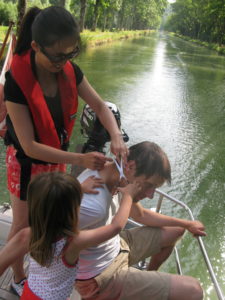
Haircutting at sea
In terms of sailing this is the worst trip so far. The day starts in fine style. Lasse and Tian Ling organize a hair salon on the aft deck. Lasses hair is cut in the breaks between locks, and Nellie tests our camera. We let her do it, although we can see, that she is pressing all the buttons and putting fingerprints on the lens. She experiments. And that makes some funny pictures.
Today’s nightmare starts immediately after lock 26, Condes, which leads us into a 308 metre long tunnel. As we approach the end of the tunnel, we see a group of boys shouting and gesturing to a buddy, who apparently is standing on top of the tunnel, ready to jump into the water. In itself wrong. The bridge over the tunnel is five or six metres above the river, and the river is only 1.80 metres deep. We can see, that the boys have a hard time convincing their buddy, that there is actually a ship coming out of the tunnel, and that he must not jump, and we also begin to roar loudly from the tunnel that here we come. “Get out of our way, please”.
He is not jumping. Obviously it is his first leap, and he is not as brave as his friends.
Then follows the three most terrible of kilometres, we have ever experienced with Ronja. She scrapes along the bottom. On long stretches of three even four hundred metres we hear and feel, how we scratch across the bottom of the canal. Heavy. Speed disparaging and horrifying. Can the boat can stick to this? Sometimes we hit an irregularity in the bottom, which gets Ronja to evert in an eerie bump, while she works over the obstacle.
We keep the engine to 2300 revolutions. We go on. We find it difficult to see an alternative. If we slow down, we will become hopelessly stuck, and then we will certainly not make it through. It will be three long kilometres. Our relief is great, when gate 27 turns up. Here the sea level is not flashy, but deep enough to once again flow with all of Ronjas beautiful body in the water.
Most of this summers stretch the bottom has consisted of mud, and that is not so bad. It takes some speed, when Ronjas keel plods through the mud bottom. On this particular stretch, however, is a rough and uneven concrete bottom. The channel is cast the entire stretch between locks 26 and 27. And the water level is significantly below the promised 1.80 meters. We later find that it is missing 40 centimetres relative to mean sea level, due to lack of rain, and because VNF has not levelled out the differences. VNF has lakes higher up, which they can use to send extra water down the system, when it is missing.
The sailors at the next port are all angry, that this has not happened.
Logbog: Today’s distance: 25 km. Sailed time 9:30 to 15:30 = 6 hours. Locks: 11. Weather: Sun all day. 27-28 degrees
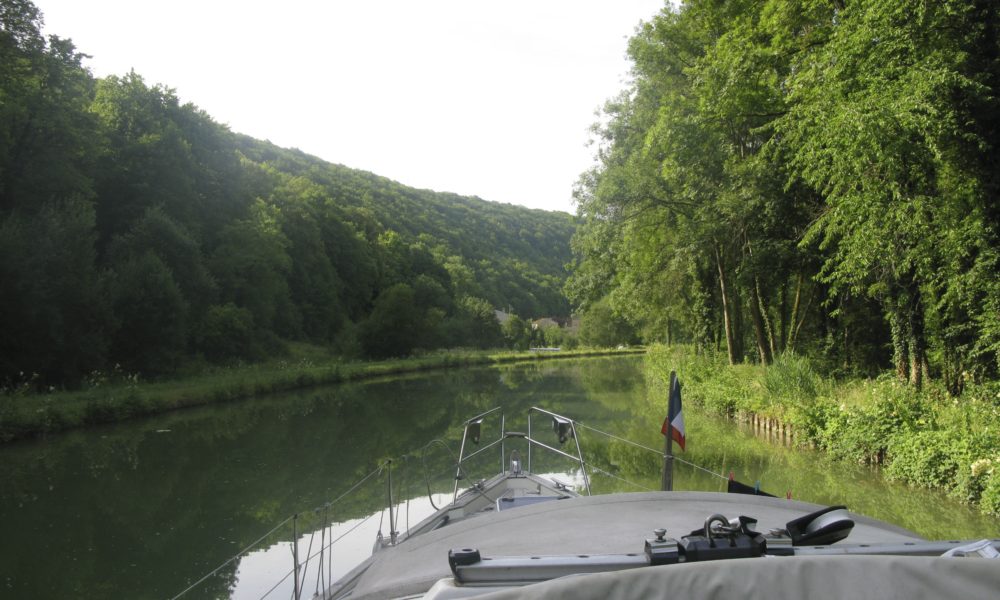
Sailing in the midst of the most beautiful nature
48° 6′ 49.4928” N 5° 8′ 21.3216” E
July 11, 2015
Two pieces of cake wrapped in tin foil is the farewell gift from the nice Brits, who will stay for another 10 days, because they are watching a dog for a friend. “We usually give the cakes to lock keepers,” they say. We ask if they are sailing all year. No, no. “The winter we spend in Spain. Only in the summer we sail in France “.
Today’s retirees have many ways of organizing their lives. Previously, we have spoken a few times with a Dutch couple, who no longer had a permanent in the Netherlands, but in the summer months sailed on the canals of Europe and in the winter lived in their apartment in Cape Town, South Africa.
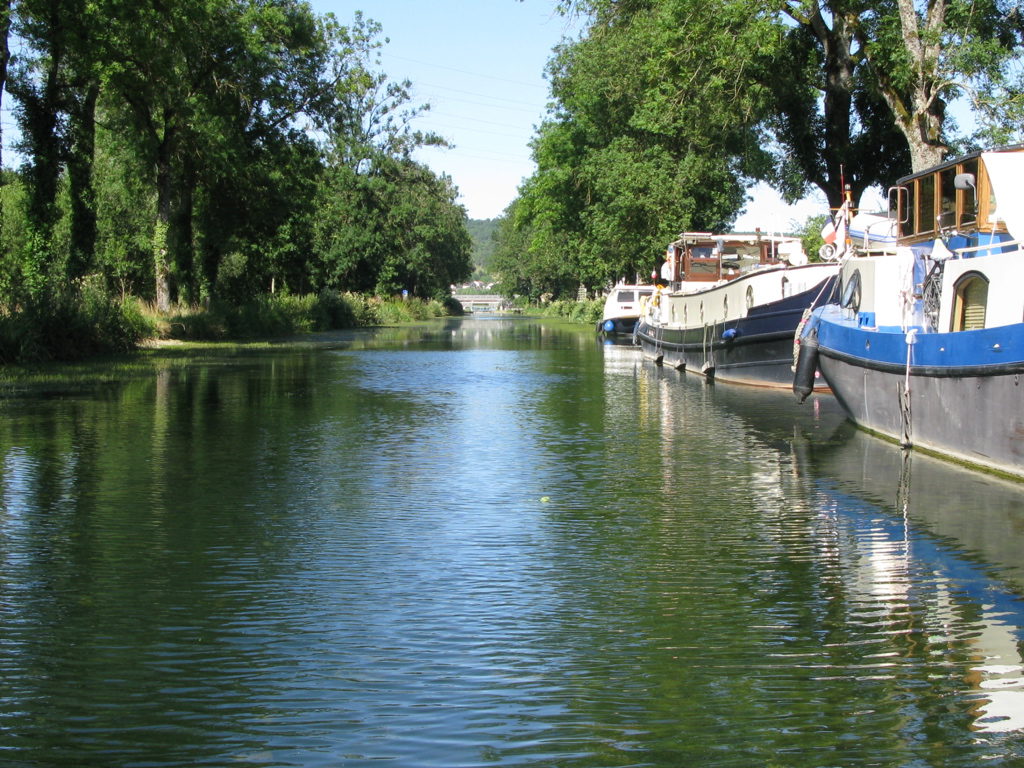
Marvellous mooring side by side with british vessels rebuild from business to leisure, spacey and modern
The ride is beautiful. The canal is curving through the landscape. Completely different from the straight channel-stretch, we have been accustomed to. Beautiful hills, rolling cornfields and lots of flowers close to the canal. The intense nature close to us is the big attraction of sailing on a canal. The banks made up of a tangle of flowers – climbing plants, thistles and many others – with purple, yellow and white as the predominant colours. A paradise for insects and birds. Dragonflies play tag. Venom spider webs are evident in the early morning hours and above us eagles are flying.
The only snake in paradise is the green sea cucumbers, which at long distances reduce our speed to less than two knots, because the keel plods through the wild growing of underwater plants. Periodically we put the engine in reverse to free the propeller of plant residues.
Lasse is driving in advance with the “follow car”, which is parked at a small jetty in Froncles. Five boats and five campers around a small piece of grass with electricity and toilets. It is fairly standard for a port in these parts. After having parked the car, he runs 14 to 15 kilometres back and meets us in a lock. Tianling jumps also gets of the boat on the way to take a walk.
It’s great to have Nellie on board. She is three and a half years old, and she is quickly settled on the boat. The large living cabin in the middle is hers. Here she is playing with clay, Legos and drawing. Here she sleeps at night. Quickly she finds out how to move around in the cockpit. Only once it goes wrong. She fell and hit her head against the rudder stock, but a heron flies over at the same time. “Look, Nellie, your happiness heron. It will see if you are seriously injured, and now flies further. ”
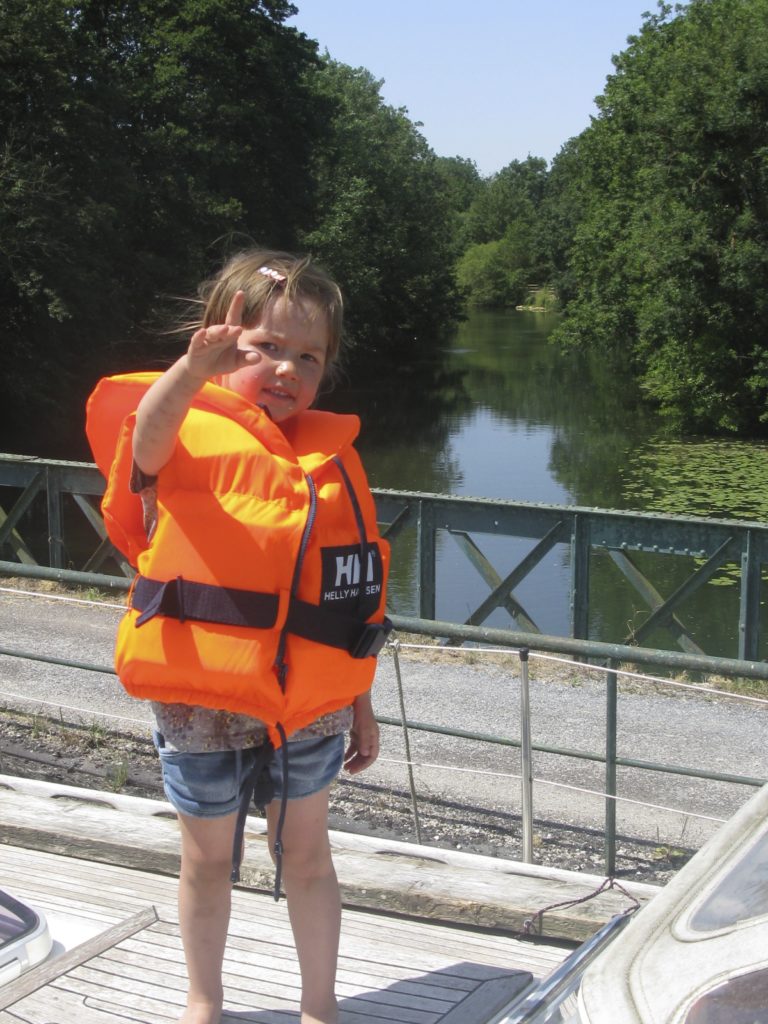
Grandchild Nellie wears lifejacket whenever close to the water
The hardest part for Nellie is the limits that naturally must be on a ship. In the cabin and cockpit, she must be without a lifejacket. But up on the deck and along the quay in the port she must always have a life jacket. After some border dispute on this, it is accepted as one of the terms of sailing life.
Log book: Today’s distance: 24 km. Sailed time 9:30 to 15:30 = 6 hours. Locks: 9 pcs. Weather: Warm, sultry, sun.
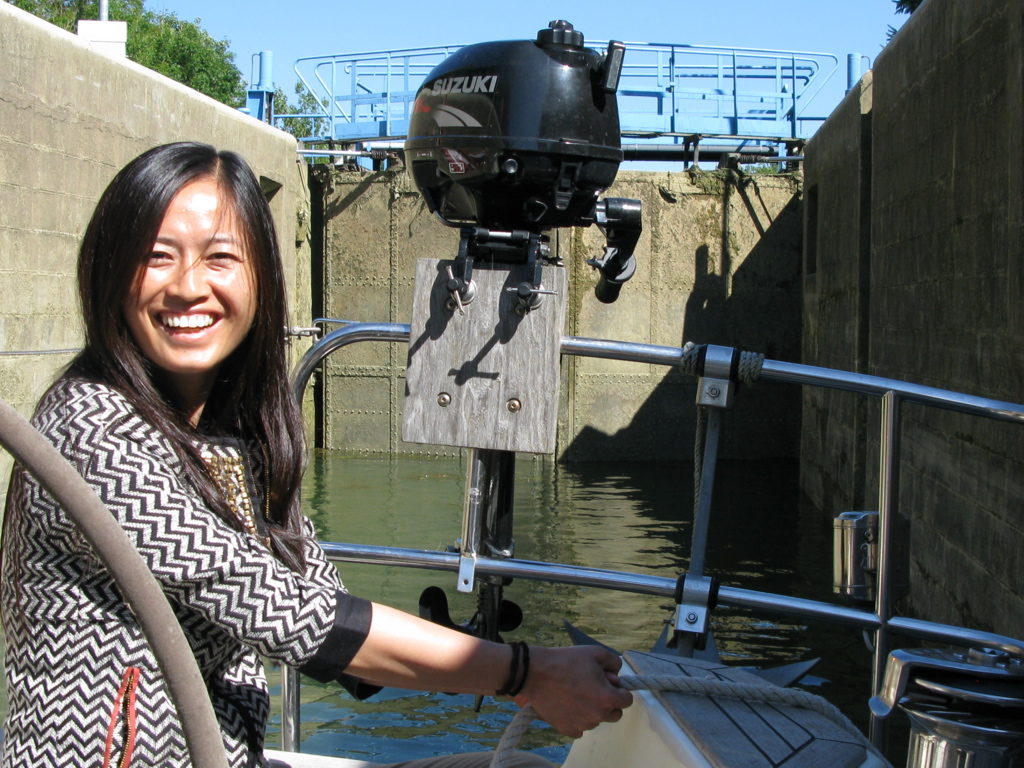
Tianling improves every day in her relatively new role as mate onboard Ronja
Help, we are under attack by green sea-sausages!
48° 37′ 1.4928” N 4° 57′ 1.3216” E
July 10. – 2015
Fresh bread. Fresh water on the tanks. New starting battery for Ronja. We are ready for a new day. Lasse drives the car to Joinville and park it, at what we assume to be our next stop. It is not. More about this later.
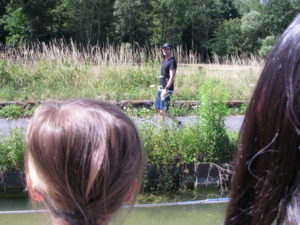
In turns we take a walking- or jogging-tour along the river. The sailing here is a bit boring, so any kind of variation is wellcomed
Lasse will run to meet us from Joinville, 24 kilometres further down the canal. He manages to run 17 kilometres, before we have him on board again.
A full day of sailing. Most locks are ready, when we come to them. Only problem is a wild, green sausage-like plant that causes the sonar to signal constant danger – 0.0 meters below the keel – and which slows us down to something like 50 percent.
We are sailing through an underwater jungle of thick, spruce-like plants that spread out from the shore and appear to be in the process of conquering the entire channel. Only in a small stream in the middle, we can fight our way forward. Regularly we had to put Ronja at full speed astern, then full speed ahead. This will free us from the most aggressive of the green sea sausages. If the French do not find out how to keep these growths down, it may close the channel-tourism in a few years.
All this coming and going. Shortly after Lasse boarded after his run, Kirsten buckles her sandals to go ahead and explore the possibilities for accommodation by walking along the canal. While we struggle our way with only two knots between the aggressive aquatic plants, Kirsten talks to people along the canal and with captains of a few peniches.
Do not stay in Joinville, they say. It’s expensive, and it’s boring. They have found a place one kilometre before Joinville. The site is located “in the middle of nowhere” with a view of fields and forests. The facilities consist of a bench. No electricity. No water. No waste containers. In return frogs croak and the channel beckons with coolness and fish, so many that a three year old can capture them with a fishing-net.
The channel is not deep enough for us to get right to the shore, so we attach ourselves to the outside of a British couple, who have been here a long time and will be here for another 10 days. Together with them we block almost the entire channel. “There will be no more boats today. We have been away all year, and there are almost no boats. We have yet to see a commercial ship in the channel, ” the brits say from their peniche with oven and air conditioning. They point in one direction: Restaurant. They point in the another direction: Supermarket. Here we have everything. The rest is incredibly beautiful scenery.
We cannot help but wonder, how the french waterways are organised. Today we had two VNF employees following us at half the trip. On their mopeds they have followed us from lock to lock, from automated bridge to automated bridge. What job they have made, is hard to sy. They have not touched a hand. Just followed our movements from a distance.
One thinks involuntarily, though it might have been better to let the locks staffed, for it seems to us, that they use the same amount of labour, now that the locks are automated.
They should use resources to keep the channels dredged and free of green “sea sausages”. Instead it seems as if they let all indulge in an unrestrained consumption of labour. Anyway: We are in France.
We eat at the restaurant a few meters from the quayside. Excellent.
Log book: Today’s distance: 23 km. Sailed time from 10.00 to 15.30 = 5 ½ hours. Locks: 10. Weather: Sun all day. No heatwave. Just hot. Such as a summer in France should be. We stopped to check the weather, so we know nothing about current or future weather conditions. Channel sailing is not as dependent on the weather as ocean navigation.
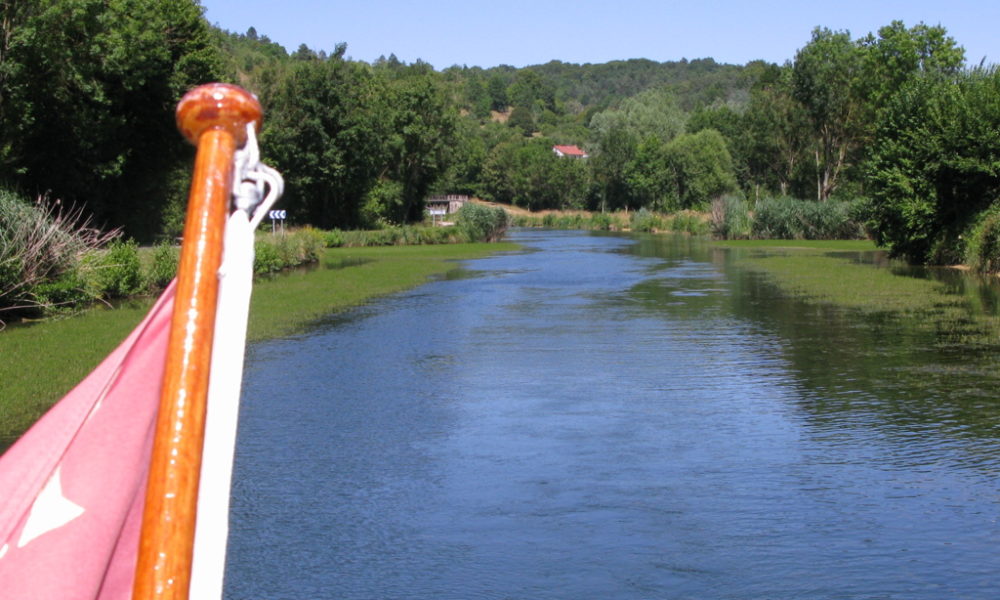
Our first serious aquaintance with seagrass
48° 40′ 8.2812”N 4° 44′ 3.1596” E
July 9, 2015
At the baker in Orconte they have a plastic-cup and a sign on the counter like in other countries, you know saying “Support the Salvation Army” or other organisations. On the Orconte-baker’s it says: “For the baker’s holiday”.
We say good-bye to our British friends. We are on to further adventures. Our first experience however is, that when we get to the first lock of the day, nothing works. We were at the first lock of the canal between Champagne and Burgundy equipped with a remote control, like a simple TV remote control, and it’s job is to manage locks, have them open, have the water emptied, so the lock is ready, when we arrive inside the gate.
But today’s first lock light is not red, and it does not change to green, when we use our remote control, which usually indicates that our signal has been received. We agree that the person, who has the job of opening the gates for a new day, has overslept. We still believe this theory.
We call VNF-guard, who assures us, that an employee will arrive promptly at the gate. This holds true, and we can see that the employee is riding to the next locks to make them ready for a new day. Given that most locks are automated, it is a very labour intensive operation that VNF is running. They move the lawns, repair and assist on a large scale. Sometimes we almost feel, that we have a personal assistant available. We only came across three other boats all day. All private boaters. No commercial ships that otherwise have priority to use the system from eight o’clock. The rest of us cannot use the locks until 9 o’clock, so the VNF employees would not open the floodgates until 9:00.
The routines around locks are in place. We spend about 15 minutes, sometimes up to 20 minutes, from the time we have activated the remote control, until we are through the lock. The locks are placed about two kilometres apart from each other.
We have begun to place our ropes closer to each other instead of a rear and a foreword placement. This means that both ropes take tension from the same direction, and it allows a fine control in the locks. All the time we take in the ropes, so the boat is parallel to the lock wall. Gone are the early days of turmoil and experimentation. Now we run uniformly, quiet and controlled lock after lock. Nellie knows her role. Below deck or in the cockpit, so grandma and grandpa can do their job
Six kilometres south of the – as seen from the canal – the grey industrial city St. Dizier we find a berth in Chamouilley. A small town that has invested in a piece of quay with room for for six-seven boats and modern automatic billing system via computer and Visa cards. We go to the quai to early. We experience low ground under the boat, and seagrass is whirled up in large quantities by the propeller. We turn the motor back, but still we probably have a decent amount of aggressive sea grass in the propeller.
We reach berth with a deluge of seagrass behind us. Luck however, comes to the person, who knows how to wait. Our British friends arrive shortly after, and the father, Charlie, takes on his goggles and dives down to check something with the cooling water on his own boat. We ask if he would take a look at our propeller. He comes back with two large handfuls of seagrass.
We ask him to check the generel state of the fouling under Ronja. She has after all not been out of the water for nearly three years. It is fine, it turns out. Presumably because of the fresh water. Finally, we ask Charlie to check the bow thruster, which was not worked since last summer. He does and tells us, that it is fine, no obstacles, no fouling, no seagrass trapped. So it must be a problem with the electric motor.
Lasse and Tialing arrive by the car, they picked up in Epernay after their mini-vacation in Paris, bringing 24 two-litre bottles of water, a new starting battery for Ronja and food for a dinner on the pier in Chamouilley, that despite the unreasonable amounts of sea grass shows up to be a nice little gem of casual nature with playground, picnic tables, benches and provincial idyll.
Log book: Today’s distance: 25 km. Sailed time 9:30 to 15:30 = 6 hours. Locks: 10. Weather: Day mild and good. We start with fleece jackets, but during the morning we get a comfortable temperature. A little sun. A little clouds. Like home.
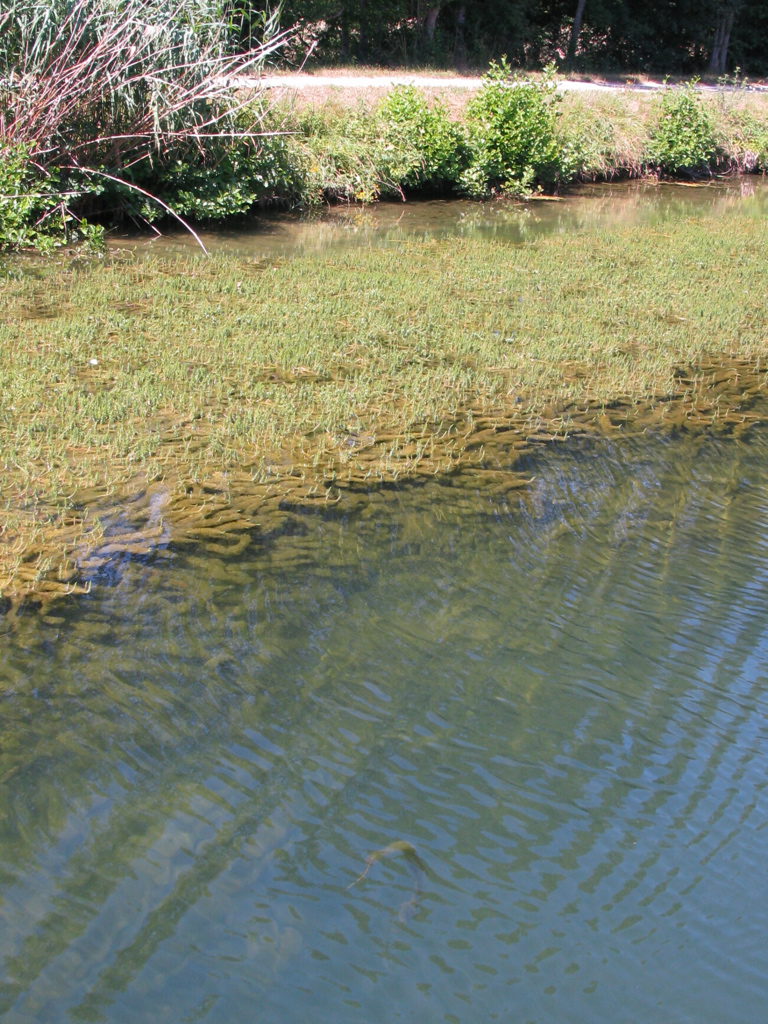
Seagrass grow fast from the brink of the channel. You can’t help wondering if one day it will close the entire channel?
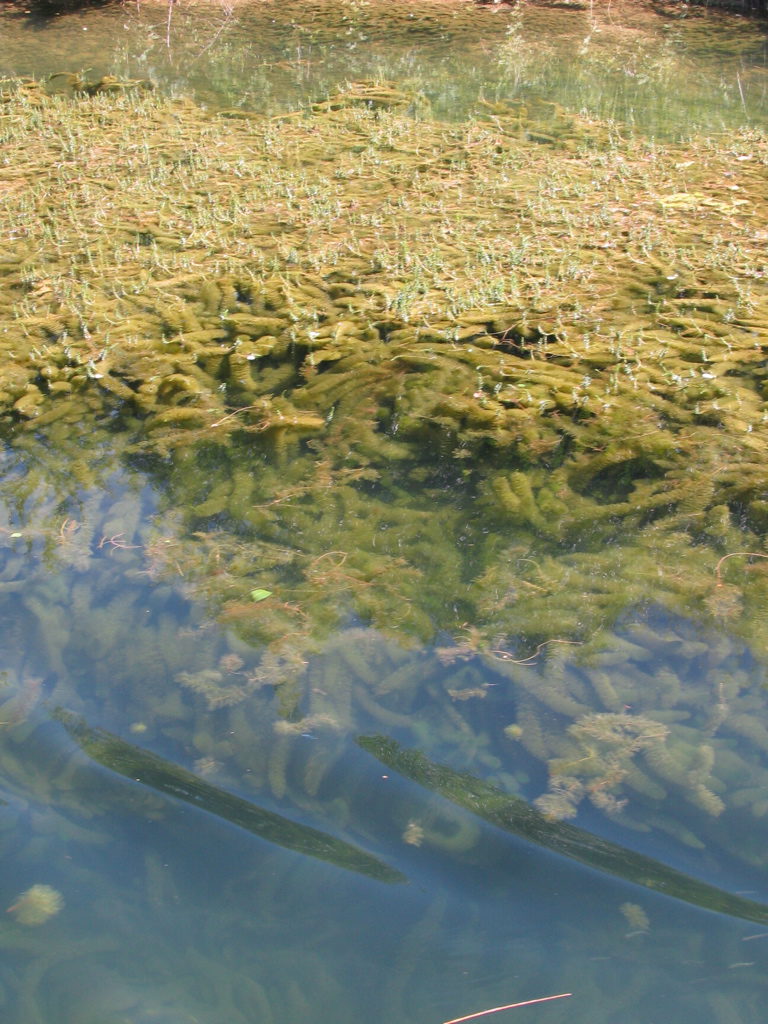
Seagrass also grows rapidly up from the bottom of the channel, and like stiff dreadlocks they go into the proppellar and lowers the speed of the boat
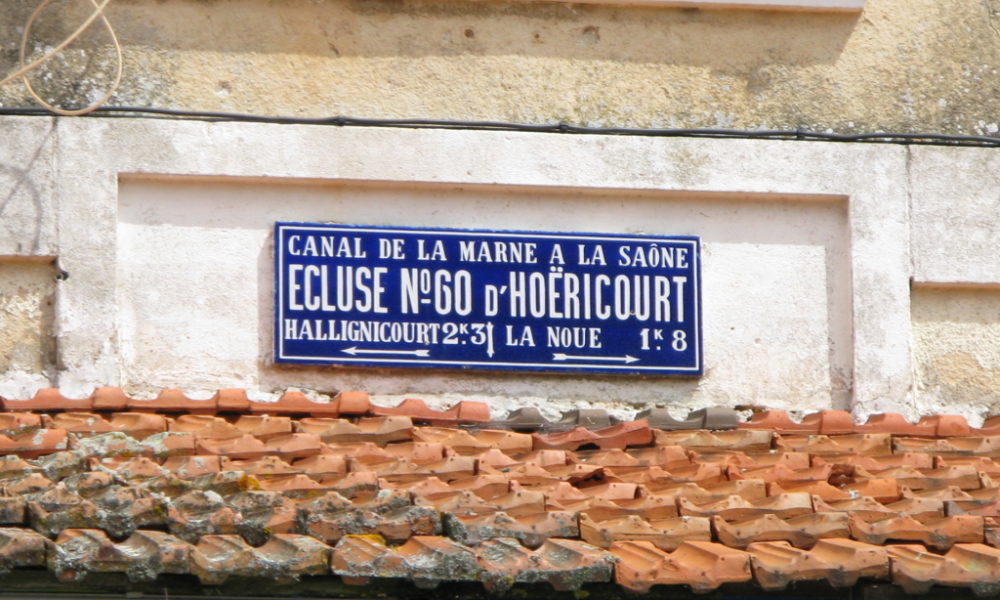
All signposts are in french. All sailors are non-french
48° 43′ 33.9132” N 4° 35′ 8.682” E
Wednesday – July 8, 2016
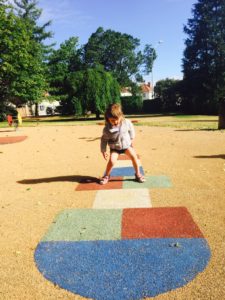
Playing in Vitry-le-Francois
Up early to go in and experience Vitry-le-Francois. We start with the playground at the town hall. Swings, slides and hopscotch. Simple but just what Nellie wants. As we pass the open windows of the town hall – a magnificent piece of classical mansion – we see that in several offices are typewriters. These analog, old-fashioned, mechanical appliances from the previous century. We also see computer screens. Anyway, typewriters in 2015? Sigh.
We eat croissant and drink coffee at a cafe. We buy Lego Friends, and we buy a long-sleeved shirt to protect Nellie against mosquito bites, and as a precaution also buy additional children’s patches, as they has been shown to have a strong psychological effect on itchy mosquito-bites. Especially those patches that have airplanes on them.
We break up at 2 p.m. There is pretty much wind. But we are a sailing boat, created for the roaring oceans. We say goodbye to our American neighbours and wish them good luck with their transmission shaft. In some way we sense that our own story with a broken shaft and many months of traumatic trouble with the French mechanics did not reassure them. Sometimes you have to just leave them to their own experience, even if you have experienced similar.
Now for the Canal entre Champagne et Bourgogne. 224 km with 114 locks and a nearly five-kilometre long tunnel along the way. It was formerly called the channel “Canal entre Marne et Saone” but one bright person at a tourist office probably got the idea to rename the channel to something with champagne and burgundy, so now it is called so – although Vitry has no more champagne-growing, and at the other end there are no single burgundy-fields. It is stagnant peasant country. Cereals and cows.
The French are not consistent. The old name, “Canal entre Marne a Saone” still occur on most signs along the canal – signs that are one hundred percent written in French. All information. All instructions. All brochures on the channel. Everything is in French. Only French. Stupid.
The French would not dream of sailing on the canals themselves. Well, except for one or two. It is Americans, Australians, British, Germans, Belgians and especially Dutch sailors that man the French rivers and channels in a fleet of converted barges, custom-built riverboats, lavish motored and castrated sailboats – including one from Denmark. We meet – virtually – no sailors from France.
Would it then make sense to make signs communicating in English or German? Yes, by God. But the French would not dream of it.
We sail to Orconte and stop at a stump berth surrounded by cornfields, trees, anglers and bird song. The only other boat at the dock are our friends from the UK, a young couple – on leave with their two children. Nice, Nellie is among friends and spends the evening with Bertie and Elisa.
Log-book: Today’s distance: 14 km. Sailed time 14.00 to 17.30 = 3 ½ hours. Locks: 6 pcs. Weather: autom-like. We woke up to the leaves falling from the trees. The wind is cold. The sky is grey. The heat wave is blown away. Back to normal?
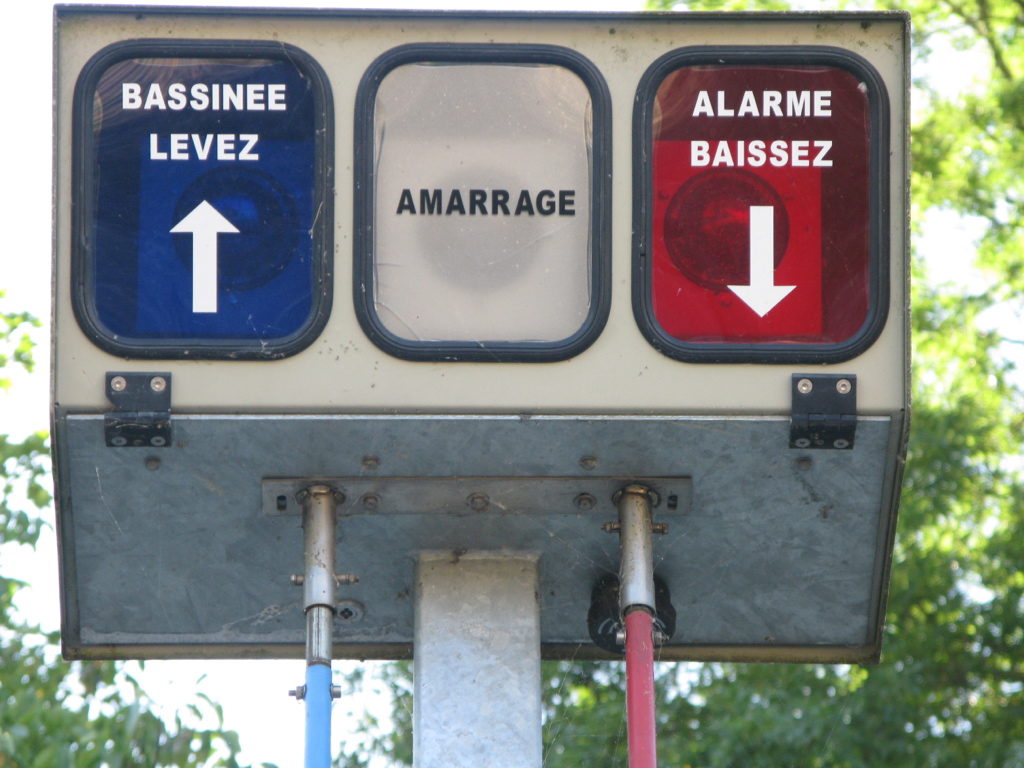
Would it help, if signposts were in english? Yes, because all sailors in the french rivers and canals are non-french
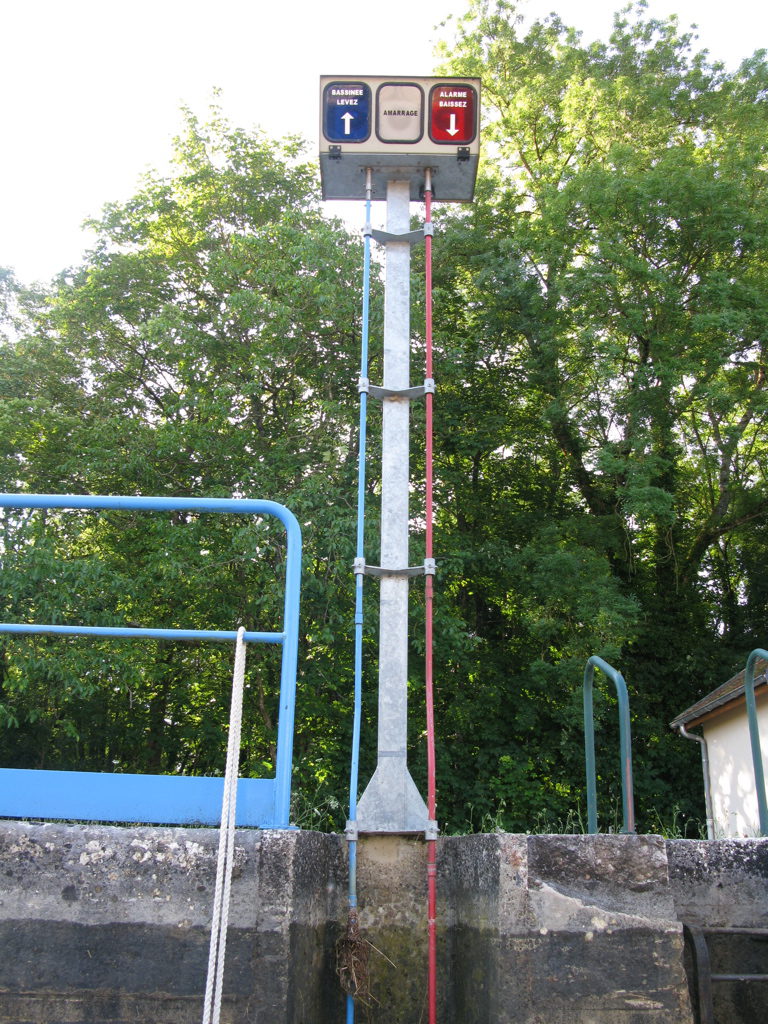
Mechanical lock. Pull up the blue tube, and the lock starts operating
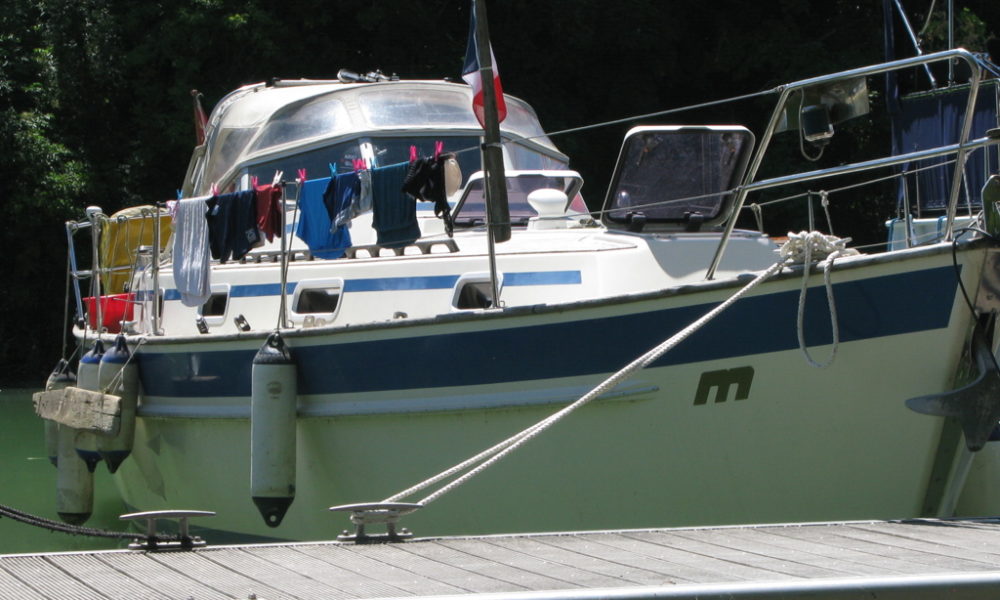
Sailing again. The french do not understand the quality of living by the water
48° 57′ 0.6336” N 4° 21′ 10.1448” E
Tuesday – July 7
We try again. We start from the quay in Chalons en Champagne. We wave good-bye to Lasse and Tianling, who walk with their backpacks to the local railway station to take the train to Paris. Nellie continues aboard Ronja with her grandparents on a new adventure through the French channels. The plan is that Lasse and Tianling will retrieve our car in Epernay and join us after a few days in Paris. – wherever we are at that time.
There was a heron sitting on a branch just 12 meters from Ronja. We tell Nellie that it is the heron, she knows from Frederiksberg Garden back in Denmark, which has come to France to ensure that she is well. A kind of happiness-heron. He will follow us the rest of the journey. Nellie seems skeptic but is not totally dismissive.
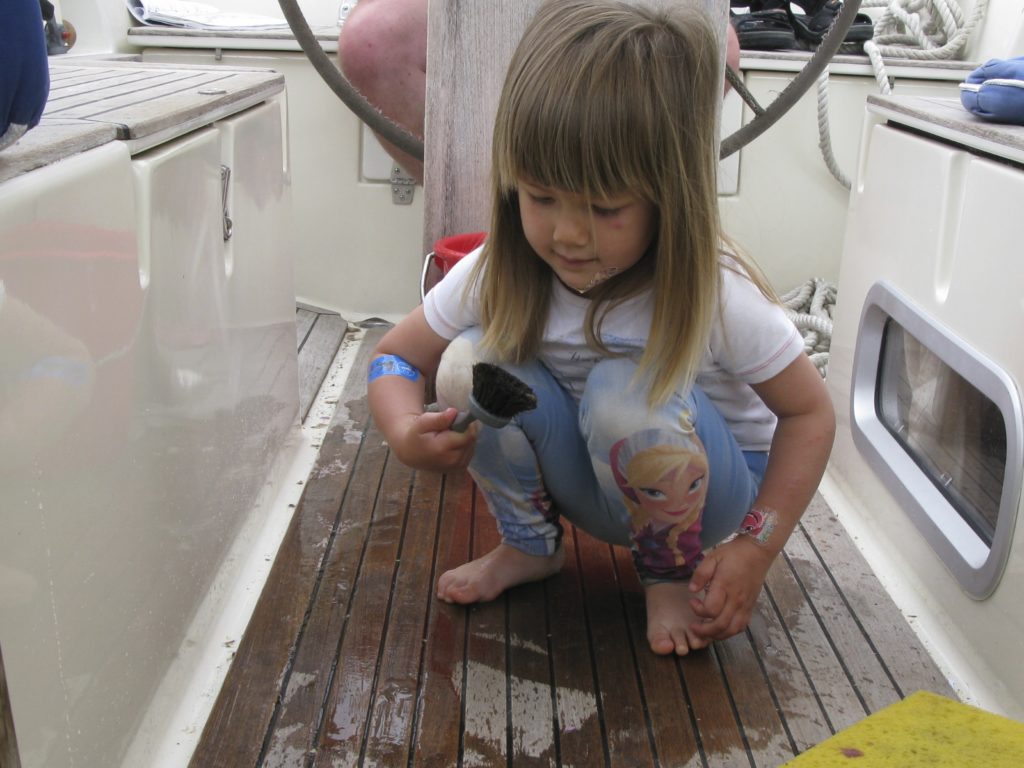
When we arrive at Vitry-en-Francois we see a flying heron. You see, Nellie, your happiness-heron is with you all the way.
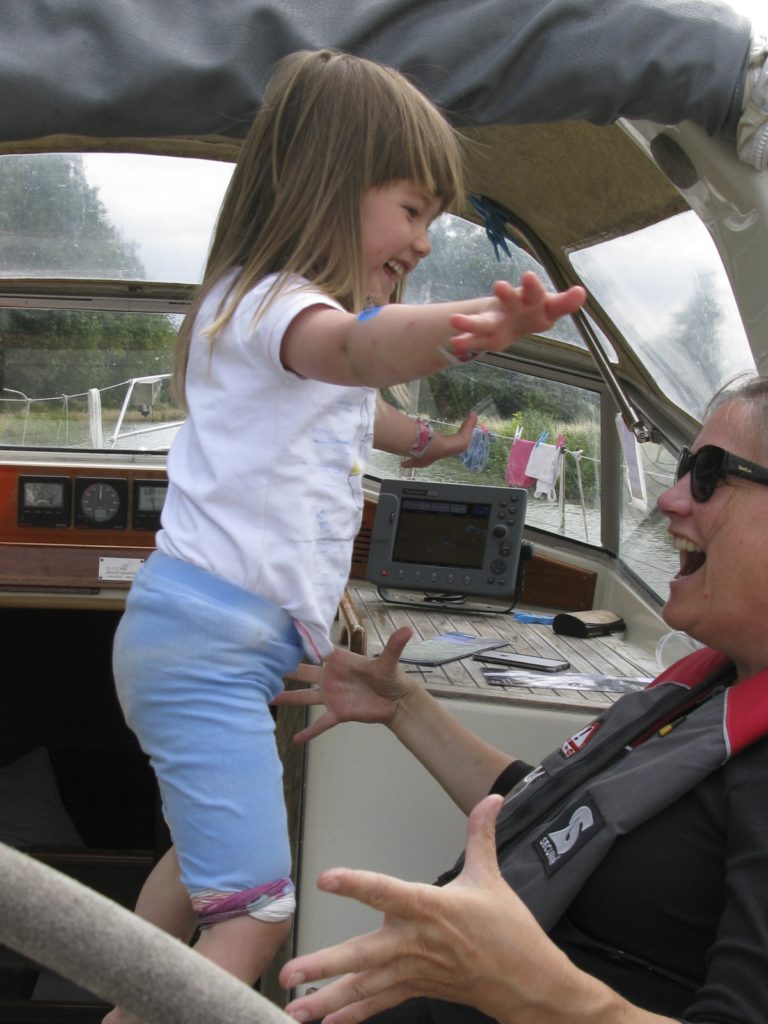
The happiness-heron flyes again, when we outside the minimalist marina of Vitry concludes, that we absolutely shouldn’t enter and find a free space in that little harbour. A sign proclaims that the water depth is 1.60 meters (we protrude 1.75), and there are already 10-12 boats in what looks like 10-12 moorings. An American yells at us. He is outside the marina and invites us to moor with him.
We do. The American pair have sailed in France for 13 years, and just today “the transmission” smoked. Total kaput. We understand their description, that “the transmission” is the same as the part that broke in our boat a year ago. Their accident had happened a kilometre from the port of Vitry. A Dutchman had passed and had towed them in. It turned out that it was the same Dutchman, we the day before had used as a sparring partner against the French mechanics.
Today’s journey has been beautiful, desolate and marked by the usual French picture: The French have not yet understood the quality of living by the water. They are “turning their back on”. They place fields, industrial plants, warehouses and the back of their homes towards the river or canal. Quite the opposite of Holland where all gardens, all houses, all panoramic windows like a natural thing face the water, and the Dutch may well have a car on the street, but it is just as natural also to have a boat out on the water.
The French have nothing. The location of the canals and rivers will be the most expensive land in France in 10-20 years. But the French have not discovered it yet. It is probably culturally determined. Something about rivers and canals have historically been regarded as dirty drains for toilet and industrial waste.
Perhaps we should start buying up the French river locations?
Log-book: Today’s distance: 32 km. Sailed time: 9:30 to 18:00 = 8 1/2 hours. Locks: 8 pcs. Weather: sultry. But after a few days with the heat wave it is a relief with temperatures of “only” 29 and 30 degrees and a slight shower of rain now and then. The lightning bolts, but even if we could use a cleansing thunderstorm, it is never close to us.
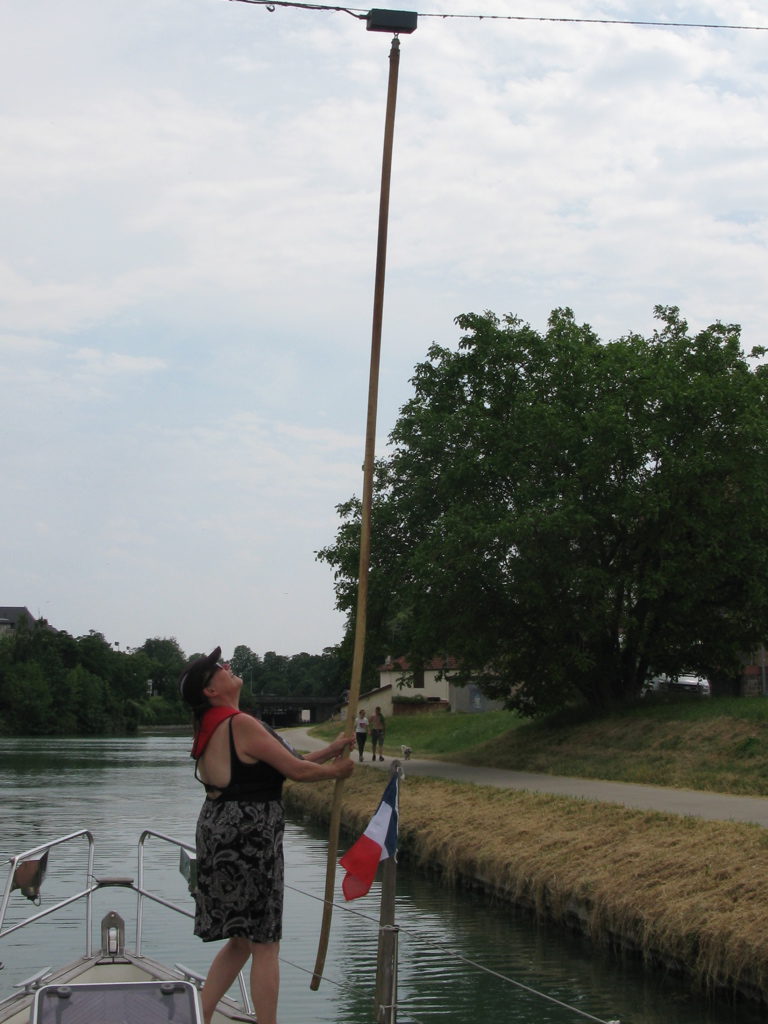
Many ways to open a lock. One of them is to turn a handle hanging down from abowe
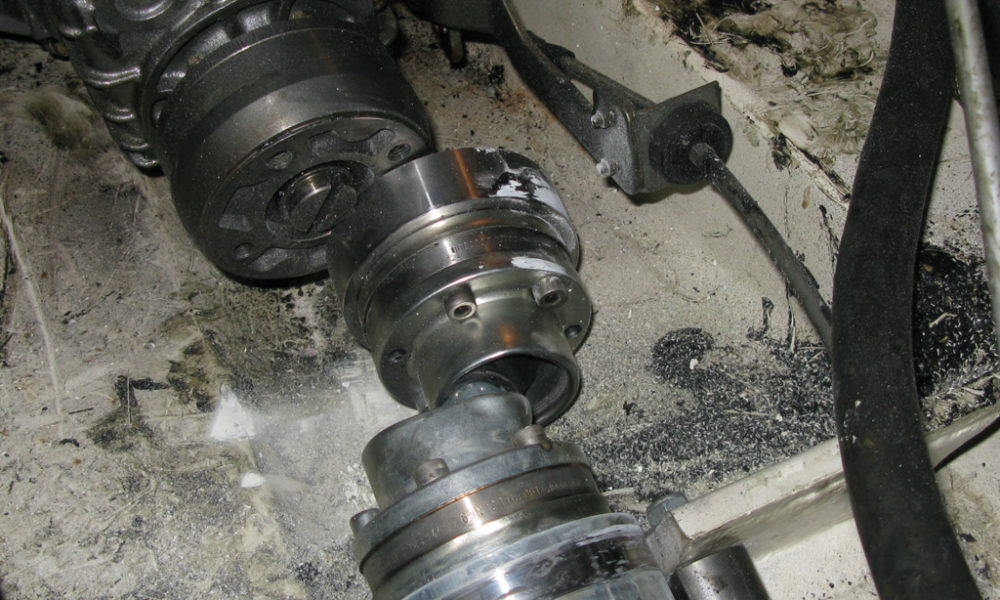
Hearts stand still. Brains refuses to believe it. The motor is broke again!
48° 57′ 0.6336” N 4° 21′ 10.1448” E
Monday – July 6
Krasch! Krasch! Krasch! Hearts are still. The brain refuses to believe it. We are shocked, when we hear the exact same sound from the engine compartment, which forced Ronja in the hands of French mechanics last year and cut off our sailing holiday, even before the first week was over. We don’t doubt: It is the universal joint that is the problem again. It has broken loose.
We see for ourselves, how last year’s tragedy now will be repeated. New mechanics, new waiting period, new parts, new repair. This year’s sailing holiday interrupted. This year after only one day of sailing.
The morning actually started with Per and Kirsten playful to be on the water again, got up early and started the engine to start today’s sailing, even while the rest of the family was still sleeping in the aft and main cabin. Ronja was not ten meters out into the basin, before the terrifying sounds from the engine compartment forced the boat back to the dock.
When we open the engine room we see a chaos of twisted metal and loose bolts. All of the spare parts had broken loose. So much for French mechanics.
As an unexpected surprise that we may yet end up with a bit of luck, the skipper of the Dutch neighbouring boat stuck his head up from his cabin: “Do you need help? I am diesel mechanic. We pinch ourselves – are our neighbour really a diesel mechanics? – and explain to him, that we will certainly need his help, and that we had a bone to pick with a specific French mechanic, who spent months repairing Ronja, only for her to break down after a single day of sailing.
Per gets hold of the harbour master, a young student who is good at English. He is briefed and dials Meca Max Service, and he makes Alain Reinhardt aware of the situation. Disaster! Totally serious! We are the beginning of a desperately short vacation. Totally unacceptable. Something must be done immediately. Tout de suite!
Hey! He is at the boat within less than half an hour. We have never experienced this before.
He jumps into the engine compartment and comes up again soon – with the harbour master as interpreter – to reassure us that it may be a problem, but it is not a serious problem. It can be solved. The replacement part is intact, but the four (or six) bolts, as the brand new universal joint are secured by, has been found to be too short. Therefore, they have twisted free. Such a large part requires a stronger attachment, he explains. We do not need a mechanic to figure that out, but we are pleased, that the disaster apparently may be limited to only one day of repair.
Two mechanics work on it for seven hours. Voila. Now we can sail again. Alain Reinhardt claims, that the new repair will last for many years, adding that today’s repair is to be considered a service. Without charge.
No charge. You bet there is no charge. Rather a warranty claim. We grits our teeth, and with a strained smile we thank him for being ready for rapid deployment. Inside we think: Hell of a truck mechanic. Next time, we must make an extra effort to find a mechanic, who knows about marine engines.
Our Dutch neighbour looks at the engine, whenever the French mechanics are home at their workshop drilling holes for longer bolts. He agrees that the problem is less serious, than it was first thought. But he is not impressed by their skills, and when we in the evening inspect the repair with him and test the engine for an hour with the gears back and forth, he declares that it will probably hold, but it is not a “nice job” they have delivered. Even we can see that.
“Garage mechanic,” snaps the Dutchman. He himself has worked with engines and engineering for major river-projects worldwide.
He stopped working a few years ago, and the decision to retire is the best, he has ever made. He and his wife are now sailing six months a year and spends the rest at home in the Netherlands. His wife whispers to us, that he has far to go, before he is relaxed pace. He is still restless even after two years in retirement.
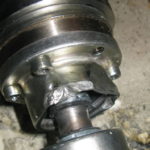
AFTER: You don’t need to be a mechanic to recognize a reparation, that is still bad
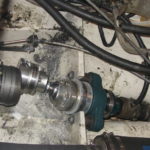
BEFORE: One day and the transmission shaft is broken again. French handycraft. Hrmppf!
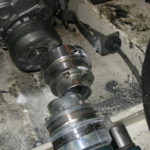
BEFORE: Bend metal and loos bolts meets the eyes in the engine-room
